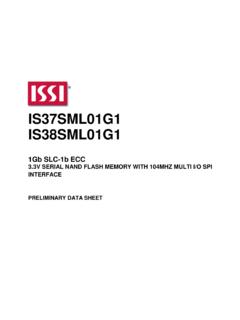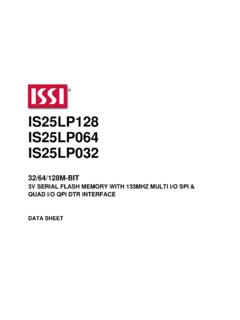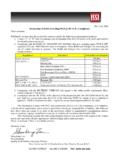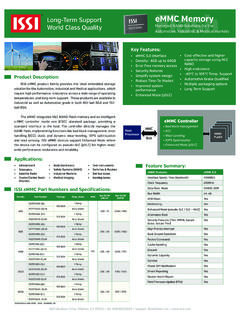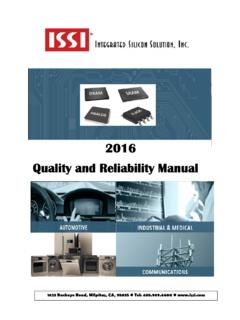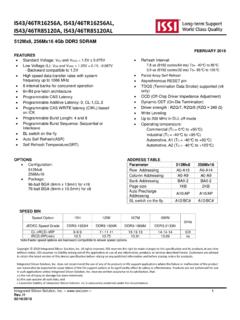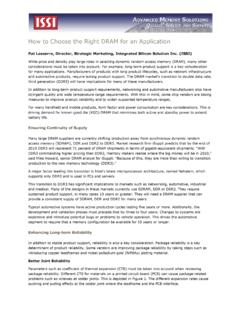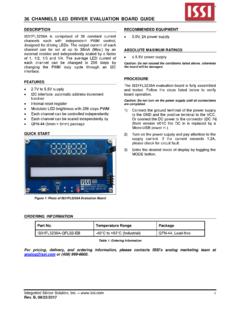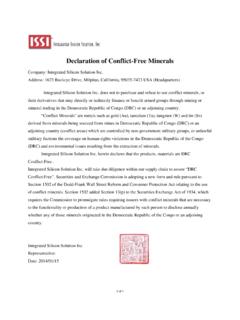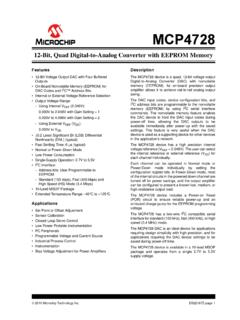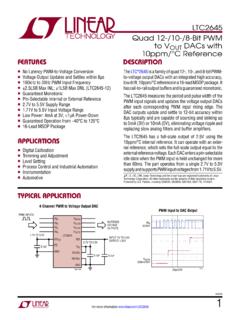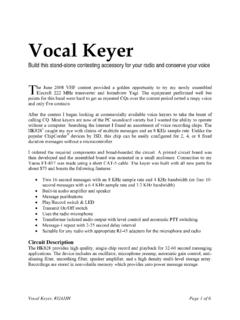Transcription of 64/128 Mbit Single Operation Voltage - ISSI
1 IS25LP016D IS25WP016D 16Mb SERIAL FLASH MEMORY WITH 133 MHZ MULTI I/O SPI & quad I/O QPI DTR INTERFACE DATA SHEET IS25LP016D IS25WP016D Integrated Silicon Solution, 2 Rev. B7 03/04/2019 FEATURES Industry Standard Serial Interface - IS25LP016D: 16 Mbit/2 Mbyte - IS25WP016D: 16 Mbit/2 Mbyte - 256 bytes per Programmable Page - Supports standard SPI, Fast, Dual, Dual I/O, quad , quad I/O, SPI DTR, Dual I/O DTR, quad I/O DTR, and QPI - Supports Serial Flash Discoverable Parameters (SFDP) High Performance Serial Flash (SPI) - 50 MHz Normal and 133 Mhz Fast Read - 532 MHz equivalent QPI - DTR (Dual Transfer Rate) up to 66 MHz - Selectable Dummy Cycles - Configurable Drive Strength - Supports SPI Modes 0 and 3 - More than 100,000 Erase/Program Cycles - More than 20-year Data Retention Flexible & Efficient Memory Architecture - Chip Erase with Uniform.
2 Sector/Block Erase (4/32/64 Kbyte) - Program 1 to 256 Bytes per Page - Program/Erase Suspend & Resume Efficient Read and Program modes - Low Instruction Overhead Operations - Continuous Read 8/16/32/64-Byte Burst Wrap - Selectable Burst Length - QPI for Reduced Instruction Overhead - AutoBoot Operation Low Power with Wide Temp. Ranges - Single Voltage Supply IS25LP: to IS25WP: to - 4 mA Active Read Current (typ.) - 5 A Standby Current (typ.) - 1 A Deep Power Down (typ.) - Temp Grades: Extended: -40 C to +105 C Auto Grade (A3): -40 C to +125 C Advanced Security Protection - Software and Hardware Write Protection - Power Supply Lock Protect - 4x256-Byte Dedicated Security Area with OTP User-lockable Bits - 128 bit Unique ID for Each Device (Call Factory) Industry Standard Pin-out & Packages(1,2) - B = 8-pin SOIC 208mil - N = 8-pin SOIC 150mil - V = 8-pin VVSOP 150mil - K = 8-contact WSON 6x5mm - U = 8-contact USON 2x3mm - T = 8-contact USON 4x3mm - M = 16-pin SOIC 300mil (Call Factory) - L = 8-contact WSON 8x6mm - G= 24-ball TFBGA 6x8mm 4x6(Call Factory) - H = 24-ball TFBGA 6x8mm 5x5 (Call Factory) - KGD (Call Factory)
3 Notes: 1. Call Factory for other package options available. 2. For the dedicated RESET# option, see the Ordering Information. 16Mb SERIAL FLASH MEMORY WITH 133 MHZ MULTI I/O SPI & quad I/O QPI DTR INTERFACE IS25LP016D IS25WP016D Integrated Silicon Solution, 3 Rev. B7 03/04/2019 GENERAL DESCRIPTION The IS25LP016D and IS25WP016D Serial Flash memory offers a versatile storage solution with high flexibility and performance in a simplified pin count package.
4 ISSI s Industry Standard Serial Interface Flash is for systems that require limited space, a low pin count, and low power consumption. The device is accessed through a 4-wire SPI Interface consisting of a Serial Data Input (SI), Serial Data Output (SO), Serial Clock (SCK), and Chip Enable (CE#) pins, which can also be configured to serve as multi-I/O (see pin descriptions). The device supports Dual and quad I/O as well as standard, Dual Output, and quad Output SPI. Clock frequencies of up to 133 MHz allow for equivalent clock rates of up to 532 MHz (133 MHz x 4) which equates to 66 Mbytes/s of data throughput.
5 The IS25xP series of Flash adds support for DTR (Double Transfer Rate) commands that transfer addresses and read data on both edges of the clock. These transfer rates can outperform 16-bit Parallel Flash memories allowing for efficient memory access to support XIP (execute in place) Operation . The memory array is organized into programmable pages of 256-bytes. This family supports page program mode where 1 to 256 bytes of data are programmed in a Single command. QPI ( quad Peripheral Interface) supports 2-cycle instruction further reducing instruction times. Pages can be erased in groups of 4 Kbyte sectors, 32 Kbyte blocks, 64 Kbyte blocks, and/or the entire chip.
6 The uniform sector and block architecture allows for a high degree of flexibility so that the device can be utilized for a broad variety of applications requiring solid data retention. GLOSSARY Standard SPI In this Operation , a 4-wire SPI Interface is utilized, consisting of Serial Data Input (SI), Serial Data Output (SO), Serial Clock (SCK), and Chip Enable (CE#) pins. Instructions are sent via the SI pin to encode instructions, addresses, or input data to the device on the rising edge of SCK. The SO pin is used to read data or to check the status of the device. This device supports SPI bus Operation modes (0, 0) and (1, 1).
7 Multi I/O SPI Multi-I/O Operation utilizes an enhanced SPI protocol to allow the device to function with Dual Output, Dual Input and Output, quad Output, and quad Input and Output capability. Executing these instructions through SPI mode will achieve double or quadruple the transfer bandwidth for READ and PROGRAM operations. QPI The device supports quad Peripheral Interface (QPI) operations only when the device is switched from Standard/Dual/ quad SPI mode to QPI mode using the enter QPI (35h) instruction. The typical SPI protocol requires that the byte-long instruction code being shifted into the device only via SI pin in eight serial clocks.
8 The QPI mode utilizes all four I/O pins to input the instruction code thus requiring only two serial clocks. This can significantly reduce the SPI instruction overhead and improve system performance. Only QPI mode or SPI/Dual/ quad mode can be active at any given time. Enter QPI (35h) and Exit QPI (F5h) instructions are used to switch between these two modes, regardless of the non-volatible quad Enable (QE) bit status in the Status Register. Power Reset or Software Reset will return the device into the standard SPI mode. SI and SO pins become bidirectional I/O0 and I/O1, and WP# and HOLD# pins become I/O2 and I/O3 respectively during QPI mode.
9 DTR In addition to SPI and QPI features, the device also supports Fast READ DTR Operation . Fast READ DTR Operation allows high data throughput while running at lower clock frequencies. Fast READ DTR Operation uses both rising and falling edges of the clock for address inputs, and data outputs, resulting in reducing input and output cycles by half. IS25LP016D IS25WP016D Integrated Silicon Solution, 4 Rev.
10 B7 03/04/2019 TABLE OF CONTENTS FEATURES .. 2 GENERAL DESCRIPTION .. 3 TABLE OF CONTENTS .. 4 1. PIN CONFIGURATION .. 7 2. PIN DESCRIPTIONS .. 9 3. BLOCK DIAGRAM .. 11 4. SPI MODES DESCRIPTION .. 12 5. SYSTEM CONFIGURATION .. 14 BLOCK/SECTOR ADDRESSES .. 14 6. REGISTERS .. 15 STATUS REGISTER .. 15 FUNCTION REGISTER .. 18 READ REGISTER AND EXTENDED REGISTER .. 19 AUTOBOOT REGISTER .. 23 7. PROTECTION 24 HARDWARE WRITE 24 SOFTWARE WRITE PROTECTION .. 24 8. DEVICE Operation .. 25 NORMAL READ Operation (NORD, 03h) .. 28 FAST READ Operation (FRD, 0Bh) .. 30 HOLD Operation .. 32 FAST READ DUAL I/O Operation (FRDIO, BBh).
